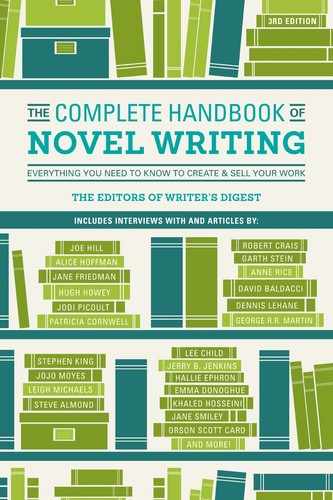0%
93Chapters
0-1Hours read
0kTotal Words
Book Description
Get advice from the best in the business on every stage of the novel-writing and publishing process!
In The Complete Handbook of Novel Writing, 3rd Edition, you'll learn from established writers about how to make your novel a reality. Discover techniques and strategies for generating ideas, connecting with readers emotionally, and finding inspiration you need to finish your work. This fully revised edition includes an updated marketing section for navigating the unique challenges and possibilities of the evolving literary marketplace.
Inside you'll find new essays from dozens of best-selling authors and publishing professionals detailing how to:
The Complete Handbook of Novel Writing is your go-to guide for every aspect of creating a bestseller.
In The Complete Handbook of Novel Writing, 3rd Edition, you'll learn from established writers about how to make your novel a reality. Discover techniques and strategies for generating ideas, connecting with readers emotionally, and finding inspiration you need to finish your work. This fully revised edition includes an updated marketing section for navigating the unique challenges and possibilities of the evolving literary marketplace.
Inside you'll find new essays from dozens of best-selling authors and publishing professionals detailing how to:
- Master the elements of fiction, from plot and character to dialogue and point of view
- Develop a unique voice and sensibility in your writing
- Manage the practical aspects of writing, from overcoming writer's block to revising your work
- Determine the key elements for success in every genre
- Find an agent, market your work, and get published--or self-publish--successfully
The Complete Handbook of Novel Writing is your go-to guide for every aspect of creating a bestseller.
Table of Contents
- Title Page
- Copyright Page
- Part One: The Art and Craft of a Strong Narrative
- Best-Selling Advice: Inspiration and Ideas
- Chapter One: Training Your Ideas
- Chapter Two: Bend It, Amp It, Drive It, Strip It
- Chapter Three: The Taming of the Muse
- Chapter Four: Testing the Strength of Your Story Ideas
- Chapter Five: Fire Up Your Fiction
- Best-Selling Advice: Plot and Structure
- Chapter Six: The Hero’s Journey
- Chapter Seven: The Two Pillars of Novel Structure
- Chapter Eight: Weaving In a Seamless Backstory
- Chapter Nine: The Essential Endgame Structure
- Chapter Ten: Supporting Stories
- Chapter Eleven: Behind the Scene
- Best-Selling Advice: Characters
- Chapter Twelve: Character Study
- Chapter Thirteen: Mining for Character
- Chapter Fourteen: The Outer Limits
- Chapter Fifteen: Complicating Your Characters
- Chapter Sixteen: Status
- Chapter Seventeen: The Main Introduction
- Best-Selling Advice: Craft and Style
- Chapter Eighteen: Transform Your Novel into a Symphony
- Chapter Nineteen: Something to Say
- Chapter Twenty: Six Powerful Ways to Maintain Suspense
- Chapter Twenty-One: Make Your Setting a Character
- Chapter Twenty-Two: Strengthening the Conflict
- Chapter Twenty-Three: Seven Tools for Talk
- Chapter Twenty-Four: Choosing the Best POV for Your Story
- Part Two: The Writing Process
- Best-Selling Advice: Getting Started
- Chapter Twenty-Five: Write Like Poe
- Chapter Twenty-Six: Break the Blocks to Creative Flow
- Best-Selling Advice: Rituals and Methods
- Chapter Twenty-Seven: Mining for Diamonds
- Chapter Twenty-Eight: Map Your Novel with a Reverse Outline
- Chapter Twenty-Nine: Creating a Flexible Outline for Any Kind of Story
- Chapter Thirty: Plantsing
- Chapter Thirty-One: Rough It Up
- Chapter Thirty-Two: Titling Your Story
- Best-Selling Advice: Revision and Editing
- Chapter Thirty-Three: The Geyser Approach to Revision
- Chapter Thirty-Four: Your Revision Checklist
- Chapter Thirty-Five: The Great Revision Pyramid
- Part Three: Exploring Novel Genres
- Chapter Thirty-Six: Literary Lust Versus Commercial Cash
- Chapter Thirty-Seven: Understanding the Elements of Literary Fiction
- Chapter Thirty-Eight: World Creation in Science Fiction
- Chapter Thirty-Nine: What "High Concept" Means in Any Genre
- Chapter Forty: Write This, Not That
- Chapter Forty-One: The Stuff Series Are Made Of
- Chapter Forty-Two: Writing Investigation
- Chapter Forty-Three: Blurred Lines
- Chapter Forty-Four: Love Gone Wrong
- Chapter Forty-Five: Between the Sheets
- Chapter Forty-Six: Know Your Young Audience
- Chapter Forty-Seven: Making Magic
- Part Four: Finding and Cultivating a Market for Your Work
- Best-Selling Advice: Publishing
- Chapter Forty-Eight: Basics of a Solid Three-Paragraph Query
- Chapter Forty-Nine: Your Guide to an Effective Novel Synopsis
- Chapter Fifty: Straw into Gold
- “NOT OUR STYLE/VOICE/TONE.”
- “WE NO LONGER ACCEPT THIS GENRE.”
- “WE AREN’T ACCEPTING NEW CLIENTS AT THIS TIME.”
- “THIS TOPIC HAS BEEN DONE TO DEATH.”
- “I REALLY LIKE YOUR PROTAGONIST, BUT I JUST CAN’T GET ON BOARD TO REPRESENT YOU.”
- “NUMEROUS GRAMMATICAL ERRORS.”
- “THE BOOK DIDN’T QUITE LIVE UP TO MY EXPECTATIONS.”
- “I RECOMMEND YOU READ OTHER AUTHORS IN YOUR GENRE.”
- “THIS ISN’T QUITE RIGHT FOR US, BUT HAVE YOU TRIED CONTACTING [INSERT NAME OF AGENT OR ACQUISITIONS EDITOR]? THIS MIGHT BE A GOOD MATCH FOR THEM.”
- “YOU MAY WANT TO CONSIDER SELF-PUBLISHING.”
- Chapter Fifty-One: Author Platform 2.0
- Chapter Fifty-Two: Going Public
- Chapter Fifty-Three: Revise Your Path to Publication
- Chapter Fifty-Four: Dissecting the Self-Publishing Contract
- Chapter Fifty-Five: Failure to Launch
- Chapter Fifty-Six: Best of Both Worlds
- Part Five: Interviews with Novelists
- Best-Selling Advice: Readers
- Chapter Fifty-Seven: David Baldacci
- Chapter Fifty-Eight: Lee Child
- Chapter Fifty-Nine: Patricia Cornwell
- Chapter Sixty: Kathryn Craft
- Chapter Sixty-One: Robert Crais
- Chapter Sixty-Two: Emma Donoghue
- Chapter Sixty-Three: Joe Hill
- Best-Selling Advice: Purpose
- Chapter Sixty-Four: Khaled Hosseini
- Chapter Sixty-Five: Hugh Howey
- Chapter Sixty-Six: Stephen King and Jerry B. Jenkins
- Chapter Sixty-Seven: Dennis Lehane
- Chapter Sixty-Eight: George R.R. Martin
- Chapter Sixty-Nine: Brad Meltzer
- Chapter Seventy: Jojo Moyes
- Chapter Seventy-One: Anne Rice and Christopher Rice
- Chapter Seventy-Two: Jane Smiley
- Chapter Seventy-Three: Garth Stein
- Permissions
